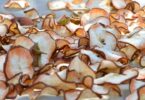Apricots are a delicious fruit, and if you’d like to keep eating them all year long, drying them is the perfect solution. It is not difficult to make dried apricots at home, but that doesn’t mean there aren’t rules to follow. In this article, you’ll get some great tips on how to dry apricots perfectly in the comfort of your own home.
As long as you follow these tips, your dried apricots should turn out great!
SEE ALSO: 15 Health Benefits of Dried Apricots (and Nutrition Facts)
How To Make Dried Apricots At Home
What should you look for in a fresh apricot?
Good dried apricots start with good fresh apricots, and you’ll want to start by buying your apricots when they are super-ripe. If you can, visit a grower late in the season when they start to have their “canning specials,” and buy your apricots at that time.
If apricots are under-ripe, they’ll taste sour when you dry them, but the longer you wait and the riper they are, the better they’ll taste when dried. In the South, you should buy your fresh apricots in June or July. If you live up North, buy them in either July or August.
You can also look for sales or specials at your local supermarket at the end of the growing season, which is in late summer or early fall. Some people are concerned about the fruit being over-ripe, but when you’re planning to dry out the apricots, that isn’t usually a problem. If you get home and realize some of your apricots are still a little green, place them in a paper bag and put them on your window sill until they get ripe enough to continue.
Getting started:)
- Once you have all of your apricots together, soak them in water for a while to get the debris off of them.
- Discard any bruised fruit, and if they do not come from an organic grower, you can add a little dishwashing detergent so the pesticides can be removed.
- After you soak them, remove any debris or dirt, and if there are any minor imperfections, you can simply cut them off. The cleaner the apricots are, the better they’ll taste when you’re done.
- Cut the apricots in half and remove the pit. Then, turn them inside out because you’ll always dry them with the inside facing up. At this point, you have several ways to begin the dehydration process, and they are all very easy.
Dehydrating Apricots in the oven
One of the easiest ways to make dried apricots at home is to dehydrate apricots in the oven …
- Line a baking sheet with parchment paper and lay all of the fruit pieces on the sheet, allowing for even spacing between them. Make sure they are facing up.
- Then place them in an oven that is set at around 175–200 degrees Fahrenheit. Never dry your apricots in an oven that is set above 200 degrees.
- Once they’re in the oven, let them cook for a minimum of 10–12 hours. About halfway through, or after 5–6 hours, turn the apricots over so they’ll cook evenly.
When your apricots are done, they’ll be a little soft but also very leathery, which is how you can tell that they’re done. Some people prefer to set the oven temperature even lower—to around 150 degrees. It will take longer for the apricots to cook, but this is still a good idea because when it comes to dehydrating fruit, lower temperatures and longer baking times work best.
Dehydrating apricots in a food dehydrator
To use a dehydrator for your apricots, you can prepare them the same way you did for the oven method.
- Instead of a baking sheet, you’ll naturally place the fruit—evenly spaced, of course—on the trays in the dehydrating machine. Again, place them on the trays facing up, and do not remove the skin beforehand.
- Once the trays are placed back into the dehydrator, set the temperature to 135 degrees Fahrenheit. You won’t know if this is the low, medium, or high setting until you read your user manual.
- Set your timer for 12 hours and wait until the timer goes off before you remove the trays from the dehydrator.
Keep checking the pieces until they have the right texture so you can know they’re done.
Dehydrating apricots in a microwave
The preparations for drying apricots in a microwave are similar to those used for the oven and dehydrator methods, but when using a microwave, always make sure that the microwave plate is clean and dry. This is because your inside-out apricot halves can be laid directly on the plate before cooking them.
After the fruit is set on the plate, cook it at the defrost level (which is usually around 50% power) for a full 30 minutes. After 30 minutes, check the fruit to see if it’s dehydrated.
The fruit pieces still have to be evenly spaced before they’re cooked, and keep in mind that this can be an unreliable way to dehydrate apricots. They may need more than 30 minutes to dry out properly, so you might have to cook them several times to get them right.
Read more about dehydrating apricots.
Storing Your Dried Apricot Pieces
Dried apricots need to be stored in some type of container that is airtight. This includes zippered plastic bags or glass jars with tight lids on them. Store them in a cool, dry place such as your pantry, because dried fruit does not like dampness or even the air. Once the dried fruit is stored properly, it can remain there for 8–12 months. Some people keep dehydrated fruit longer than this, but to be on the safe side, stick with 8–12 months instead.
Conclusion
Making dried apricots at home is not complicated, but the right preparation and the rules regarding the dehydration process are important. If you follow these simple rules, you should have great-tasting dried fruit in the end. Some people also dry their fruit outside in the sun to get the apricots nice and dry, but this is a time-consuming process that could take as much as seven days. If you don’t have that kind of time, stick with the other methods of fruit dehydration.





